Tài nguyên
Tài nguyên khẩn cấp
Tài nguyên Chuẩn bị Khẩn cấp. Vui lòng nhấp vào từng phần để biết thêm thông tin về các thảm họa có thể xảy ra khác nhau trong khu vực của chúng ta và những gì bạn có thể làm hôm nay để tự chuẩn bị.
Sự cố & Sự kiện Hiện tại:
Không có sự cố hoặc sự kiện hiện tại để báo cáo tại thời điểm này.
Winter Weather
Winter weather brings with it a multitude of different challenges and concerns for safety. In addition to preparing for extreme cold with the information provided below, you will also find information in the links to Public Safety Power Shutoff, Flood, and General Emergency Preparedness very useful to be prepared for winter related emergencies. What constitutes extreme cold and its effects can vary across different areas of the country. In regions relatively unaccustomed to winter weather, near freezing temperatures are considered “extreme cold.” Whenever temperatures drop decidedly below normal and as wind speed increases, heat can leave your body more rapidly. Exposure to cold temperatures, whether indoors or outside, can cause other serious or life-threatening health problems and anyone can be affected. To keep yourself and your family safe, you should know the early warning signs of hypothermia and what to do to prevent cold-weather health emergencies.
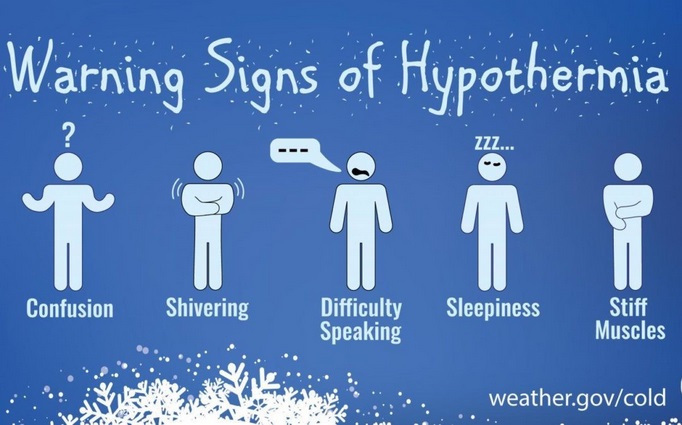
Hypothermia occurs when more heat escapes from your body than your body can produce. Hypothermia usually occurs gradually. Often, people aren’t aware that they need help, much less medical attention. Signs and symptoms of hypothermia may include:
- the “-umbles“: Stumbles, Mumbles, Fumbles, Grumbles and/or slurred speech
- gradual loss of mental and physical abilities
- shivering, which is your body’s attempt to generate heat through muscle activity
- abnormally slow rate of breathing and cold, pale skin
- unusual or extreme fatigue, lethargy or apathy.
Persons exhibiting these symptoms need medical attention immediately.
Understand Wind Chill
The Wind Chill index is the temperature your body feels when the air temperature is combined with the wind speed. It is based on the rate of heat loss from exposed skin caused by the effects of wind and cold.
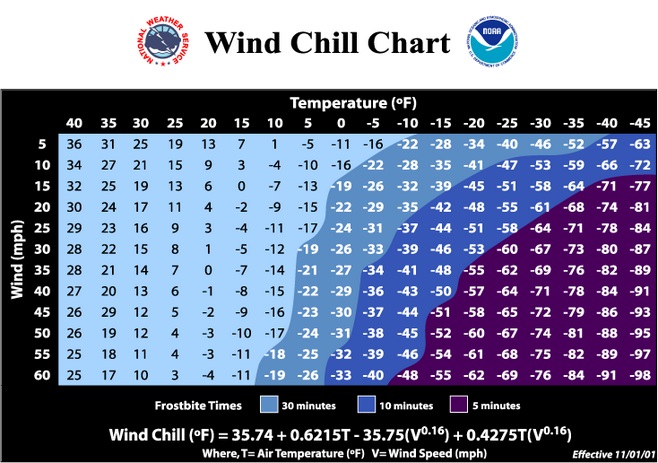
Dressing warmly when it is very cold out is dressing for success. Be sure the outer layer of your clothing is tightly woven, preferably wind resistant, to reduce body-heat loss caused by wind. Wool, silk, or polypropylene inner layers of clothing will hold more body heat than cotton. Stay dry— wet clothing chills the body rapidly. Excess perspiration will increase heat loss, so remove extra layers of clothing whenever you feel too warm.
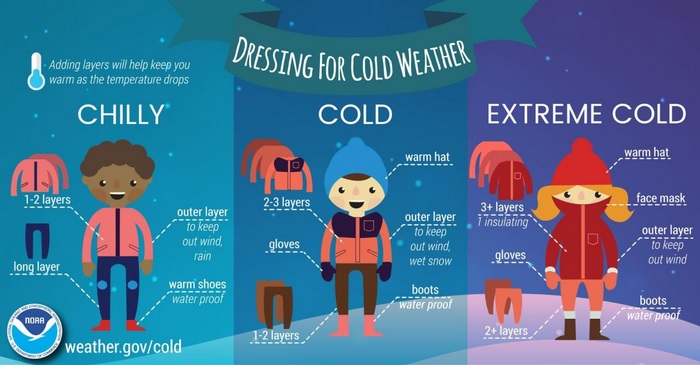
Tài nguyên bổ sung:
https://www.ready.gov/winter-weather
Chuẩn bị khẩn cấp chung
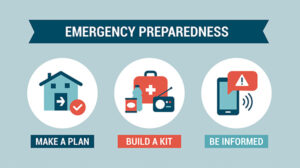
Thực hiện 3 bước đơn giản này để chuẩn bị cho bạn, gia đình, hộ gia đình của bạn và những người xung quanh bạn đối phó với tình huống thảm họa có thể xảy ra.
- Lên kế hoạch
- Lập kế hoạch về cách bạn sẽ sơ tán khỏi nhà và nơi bạn sẽ gặp sau khi sơ tán
- Tạo một danh sách các số liên lạc khẩn cấp và tên cho:
- Một người sống gần đó (chẳng hạn như hàng xóm hoặc người quản lý căn hộ)
- Gia đình hoặc bạn bè
- Liên hệ quan trọng khác
- nhân viên hỗ trợ
- Điều phối viên dịch vụ trung tâm khu vực
- Xây dựng một bộ:
- Tạo một bộ dụng cụ khẩn cấp được cá nhân hóa với các tài nguyên dành riêng cho nhu cầu của bạn.
- Nhu cầu cơ bản là:
- Nước
- Thực phẩm (Kệ thực phẩm ổn định)
- Quần áo bổ sung (bao gồm cả áo khoác)
- Găng tay
- Dịch Vụ Cung Cấp Thú Cưng
- Sơ cứu cơ bản
- Thuốc cần thiết của bạn
- Còi
- Túi rác
- Radio hoạt động bằng pin hoặc quay tay
- Đèn pin hoạt động bằng pin hoặc quay tay
- Pin dự phòng
- Tiền mặt
- Giữ một bản sao (các) Thẻ Bảo hiểm & Chứng minh nhân dân, các tài liệu quan trọng và kế hoạch khẩn cấp với các số liên lạc khẩn cấp được niêm phong trong một túi nhựa.
- Nhu cầu cơ bản là:
- Tạo một bộ dụng cụ khẩn cấp được cá nhân hóa với các tài nguyên dành riêng cho nhu cầu của bạn.
- Được thông báo
- Hệ thống thông báo khẩn cấp theo quận
- Hạt Santa Clara – Alert SCC là hệ thống cảnh báo và cảnh báo khẩn cấp chính thức của Hạt Santa Clara. Công cụ này sẽ giúp bạn có được thông tin cập nhật nhất về các trường hợp khẩn cấp và thảm họa xảy ra trong khu vực của bạn.
- Quận Monterey – Nixle và Cảnh báo Quận Monterey là hai nguồn tuyệt vời để cung cấp cảnh báo và cảnh báo qua email hoặc tin nhắn văn bản.
- Quận Santa Cruz & San Benito – Code Red là hệ thống Thông báo Khẩn cấp được sử dụng bởi Santa Cruz và Quận San Benito 9-1-1 để gửi các thông điệp quan trọng đến cộng đồng.
- Radio Stations để điều chỉnh vào
- Quận Santa Clara
- KSJO 92,3 FM
- KFRC 106,9 FM hoặc 740 AM
- KSJX 1500 AM (Tiếng Việt)
- KSOL 98,9/99,1 FM (tiếng Tây Ban Nha)
- KSQQ 96.1 FM (tiếng Trung)
- Quận Santa Cruz
- KSCO 1080 sáng
- KTOM 92,7 FM
- Quận Monterey:
- KPIG 107,5 FM
- Hạt San Benito:
- KTOM 92,7 FM
- Quận Santa Clara
- Biết khu vực sơ tán của bạn.
- Hạt Santa Clara – xem trang tài nguyên của Sở Cứu hỏa Hạt Santa Clara để xác định khu vực sơ tán của bạn.
- Quận Santa Cruz – Quận Santa Cruz đã tạo trang này để tìm khu vực sơ tán của bạn.
- Quận San Benito – Quận San Benito sẽ cung cấp thông tin cập nhật về sơ tán và thông tin cụ thể về mối nguy hiểm trên trang web của quận.
- Quận Monterey – Quận Monterey sẽ cung cấp thông tin cập nhật trên trang web của họ về các hoạt động sơ tán và thông tin cụ thể về mối nguy hiểm khác.
- Ứng dụng điện thoại di động để biết thêm thông tin
- Giám sát cháy rừng - Ứng dụng Watch Duty cho phép bạn cập nhật thông tin về các vụ cháy rừng trong khu vực của mình. Watch Duty sẽ giúp bạn cập nhật thông tin từ Cal Fire và những người phát hiện đám cháy cho những việc như sơ tán, ngăn chặn sự lây lan, v.v.
- Ứng dụng Rescu – thiết lập Ứng dụng Rescu để giúp những Người phản hồi đầu tiên hỗ trợ bạn bằng cách lưu trữ thông tin và gọi hỗ trợ bằng hai lần bấm nút đồng thời thông báo cho các liên hệ khẩn cấp của bạn.
- Hội Chữ thập đỏ Hoa Kỳ – Hội Chữ thập đỏ Hoa Kỳ có nhiều ứng dụng dành riêng cho thảm họa, chẳng hạn như Ứng dụng Khẩn cấp và Ứng dụng Động đất, cùng với các ứng dụng hướng dẫn cách sơ cứu cơ bản, v.v.
- Ứng dụng di động của FEMA – FEMA đã tạo một ứng dụng điện thoại miễn phí để giúp bạn nhận các cảnh báo thời tiết theo thời gian thực, xác định vị trí các nơi trú ẩn khẩn cấp tại địa phương trong khu vực của bạn và hơn thế nữa.
- Hệ thống thông báo khẩn cấp theo quận
sóng nhiệt
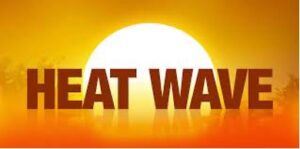
Sóng Nhiệt xảy ra khi chúng ta trải qua nhiệt độ rất cao vào ban ngày với nhiệt độ cao hơn bình thường vào buổi tối hoặc qua đêm. Sóng nhiệt thường xảy ra trong những tháng mùa hè. Điều quan trọng là bạn phải chuẩn bị cho bản thân, những người xung quanh và nhà của bạn đối phó với một đợt nắng nóng có thể xảy ra.
Những điều cần làm để giúp bạn khỏe mạnh và an toàn trong một đợt nắng nóng:
- Uống nhiều nước – ngay cả trước khi bạn khát (tránh đồ uống có đường và đồ uống có caffein.
- Hạn chế hoạt động thể chất trong giờ nắng nóng cao điểm từ 10 giờ sáng đến 3 giờ chiều – thay vào đó hãy chọn hoạt động vào buổi sáng hoặc buổi tối.
- Không bao giờ để người ở mọi lứa tuổi, vật nuôi, thuốc men hoặc thức ăn trong một chiếc ô tô đang đỗ và đóng kín.
- Ở trong khu vực có máy lạnh bất cứ khi nào có thể.
- Mặc quần áo mát mẻ – nên mặc quần áo nhẹ, sáng màu và rộng rãi để giúp bạn mát mẻ.
- Thoa kem chống nắng và đeo kính râm khi ra ngoài
- Che đầu – đội mũ rộng vành, có lỗ thông hơi hoặc sử dụng ô vì nhiệt của bạn dễ dàng hấp thụ nhiệt.
Dưới đây là các nguồn hỗ trợ trong đợt nắng nóng:
- Nơi trú ẩn làm mát khẩn cấp – những nơi miễn phí trong cộng đồng của bạn để chờ đợi thời điểm nóng nhất trong ngày.
- Mẹo & Tài nguyên của PG&E để giữ mát, tiết kiệm năng lượng và lập kế hoạch khẩn cấp để giữ mát.
- Văn phòng Dịch vụ Khẩn cấp California – Thông tin Cảnh báo Linh hoạt và Lời khuyên để Giữ Bình tĩnh
- Kiểm tra xem nơi cư trú của bạn có phải là mục tiêu bị cúp điện luân phiên với PG&E hay không.
cháy rừng
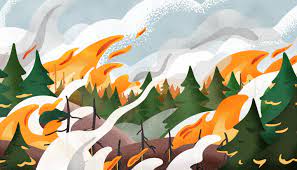
Mùa cháy rừng là từ tháng 5 đến tháng 11; tuy nhiên, cháy rừng có thể xảy ra bất cứ lúc nào. Hãy chắc chắn rằng bạn và gia đình của bạn đã chuẩn bị.
Mẹo sơ tán khi cháy rừng:
- Đóng tất cả các cửa sổ và cửa ra vào, để chúng không khóa.
- Loại bỏ mành cửa sổ dễ cháy, rèm cửa và đóng cửa chớp kim loại.
- Di chuyển đồ đạc dễ cháy ra giữa phòng, cách xa cửa sổ và cửa ra vào.
- Ngắt xăng tại đồng hồ đo; tắt đèn hoa tiêu.
- Để đèn của bạn sáng để lính cứu hỏa có thể nhìn thấy ngôi nhà của bạn trong điều kiện khói.
- Tắt điều hòa.
- Thu gom các vật dụng dễ cháy bên ngoài ngôi nhà và mang chúng vào bên trong.
- Tắt bình propan.
- Di chuyển các thiết bị BBQ propane ra khỏi các công trình.
- Kết nối nhà vườn với van nước bên ngoài hoặc vòi để lính cứu hỏa sử dụng.
- Không để vòi phun nước hoặc nước chảy, chúng có thể ảnh hưởng đến áp suất nước quan trọng.
- Để đèn bên ngoài bật để nhân viên cứu hỏa có thể nhìn thấy ngôi nhà của bạn trong khói hoặc bóng tối của màn đêm.
- Đặt Bộ tiếp liệu khẩn cấp trong xe của bạn.
- Lùi xe của bạn vào đường lái xe khi đã chất đầy xe và đóng tất cả các cửa ra vào và cửa sổ. Mang theo chìa khóa xe của bạn với bạn.
Tài nguyên:
- CalFire đã tạo ra hướng dẫn về cách chuẩn bị cho ngôi nhà và môi trường xung quanh của bạn đối phó với khả năng xảy ra cháy rừng.
- CalFire đã tạo các nguồn lực khi có lệnh sơ tán.
- USDA đã tạo một danh sách kiểm tra sơ tán hỏa hoạn để giúp các cá nhân chuẩn bị ở nhà cho một vụ cháy rừng.
Ngắt Điện An Toàn Công Cộng (PSPS)/Cắt Điện
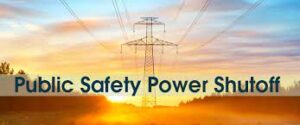
Cắt Điện An Toàn Công Cộng, còn được gọi là các sự kiện PSPS, là các đợt cắt điện theo kế hoạch do công ty điện lực (trong trường hợp của chúng tôi là PG&E) thực hiện để giúp giảm khả năng xảy ra thảm họa liên quan đến điện – chẳng hạn như cháy rừng. Với các sự kiện PSPS, mất điện mà nhiều người cần để tồn tại.
Mất điện có thể gây khó chịu và là sự gián đoạn không mong muốn đối với cuộc sống của bạn; PG&E đã tạo ra các mẹo chuẩn bị để giữ an toàn cho bạn và cuộc sống của bạn bình thường nhất có thể trong sự kiện PSPS.
- Hãy chắc chắn rằng bạn có thực phẩm an toàn để ăn.
- Làm đá trước để bảo quản và giữ lạnh thực phẩm trong tủ lạnh cũng như thực phẩm trong tủ đông ở nhiệt độ tối ưu khi mất điện.
- Đảm bảo hạn chế số lần bạn mở tủ lạnh và cửa tủ đông để đảm bảo thực phẩm của bạn được giữ lạnh lâu hơn.
- Hãy chắc chắn rằng bạn có thức ăn mà bạn có thể ăn mà không cần nguồn điện để làm cho thức ăn có thể tiêu thụ được.
- Đảm bảo rằng bạn có kế hoạch cho những vật dụng trong nhà có thể cần nguồn điện.
- Đảm bảo bạn có chìa khóa dự phòng hoặc bộ pin dự phòng cho ổ khóa và các thiết bị điện tử khác cần nguồn điện để chạy.
- Đảm bảo bạn có đài có pin hoặc tay quay có thể cung cấp các bản cập nhật quan trọng khi cần để đảm bảo bạn luôn cập nhật.
- Lập kế hoạch về nơi bạn có thể nhận WIFI miễn phí nếu bạn cần truy cập internet.
Tài nguyên:
- Quỹ California dành cho các Trung tâm Sống Độc lập và Tiếp cận Thảm họa dành cho Người khuyết tật đã hợp tác với nhau để cung cấp pin dự phòng di động miễn phí cho các cá nhân sử dụng thiết bị y tế. Để đăng ký các tài nguyên này, vui lòng điền vào Đơn đăng ký tài nguyên & tiếp cận thảm họa dành cho người khuyết tật tại đây.
- Chương trình Medical Baseline – do PG&E tổ chức, là một chương trình hỗ trợ cung cấp 2 loại hỗ trợ cho khách hàng dân cư phụ thuộc vào nguồn điện cho các nhu cầu y tế. Hỗ trợ nếu ở dạng phân bổ năng lượng bổ sung hàng tháng ở mức giá thấp nhất theo mức giá hiện tại của bạn và các thông báo bổ sung trước khi cắt điện để đảm bảo an toàn công cộng. Kiểm tra trang web của PG&E để tìm hiểu xem bạn có đủ điều kiện hay không.
- FEMA đã tạo ra các hướng dẫn và đề xuất về cách chuẩn bị cho trường hợp mất điện có thể xảy ra. Xem các đề xuất về nguồn điện thay thế, thiết bị gia dụng, kho chứa thực phẩm, v.v.. Đảm bảo rằng bạn biết và hiểu nhu cầu y tế của mình để đảm bảo bạn có sẵn kế hoạch nếu bạn cần thuốc hoặc thiết bị được bảo quản ở nhiệt độ cụ thể.
- Tài nguyên PG&E để xác định vị trí Trung tâm tài nguyên cộng đồng – nơi bạn có thể sử dụng các tài nguyên như phòng vệ sinh, sạc thiết bị y tế cơ bản, sạc thiết bị không cần thiết khác, WIFI và các tiện nghi khác trong khi chờ điện được phục hồi.
động đất
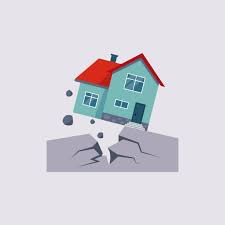
Động đất là sự rung chuyển đột ngột, nhanh chóng của trái đất do sự dịch chuyển của đá bên dưới bề mặt trái đất. Động đất xảy ra mà không có cảnh báo trước và vào bất kỳ thời điểm nào trong năm, ngày hay đêm.
Trong một trận động đất:
- Giữ bình tĩnh. Đừng ra khỏi tòa nhà. Không sử dụng bất kỳ thang máy nào khi mặt đất đang rung chuyển hoặc sau khi hết rung lắc, cho đến khi bạn biết thang máy an toàn.
- Di chuyển ra khỏi chu vi của tòa nhà. Tránh xa cửa sổ, tủ sách, đồ nội thất nặng khác và bất kỳ đồ vật nào có thể rơi hoặc vỡ.
- Theo cụm từ THẢ-BÌA-GIỮ
- Thả – xuống đất và tìm vật dụng trú ẩn lớn gần nhất (chẳng hạn như bàn làm việc, bàn chắc chắn, v.v.)
- Che – đầu và cổ của bạn bên dưới mái che để bảo vệ cột sống, cổ và đầu của bạn.
- Giữ- giữ vào đáy của nơi trú ẩn mà bạn đang sử dụng. Gợi ý tốt nhất là vòng tay quanh chân bàn hoặc bàn làm việc. Điều này đảm bảo rằng khi cuộn/sóng của trận động đất đi qua, bạn không bị kéo ra khỏi nơi trú ẩn của mình.
- Nếu bạn sử dụng thiết bị hỗ trợ di chuyển như gậy, khung tập đi hoặc xe lăn, vui lòng xem đồ họa trên trang web của quốc gia xảy ra động đất để xác định cách bạn nên tự bảo vệ mình.
- Những người sử dụng gậy: Khuyến nghị là Hạ xuống – Che chắn – Giữ chặt
- Những người sử dụng khung đi bộ: Khuyến nghị là Khóa (khung đi bộ của bạn) – Che (ngồi xuống khung đi bộ của bạn (nếu có) và che đầu và cổ của bạn bằng bất cứ thứ gì bạn có xung quanh) – Giữ (lên khung đi bộ của bạn và bất cứ thứ gì bạn đang sử dụng để che đầu và cổ của bạn)
- Những người sử dụng xe lăn: Khuyến nghị là Khóa (xe lăn của bạn) – Che (che đầu và cổ của bạn bằng bất cứ thứ gì bạn có xung quanh) – Giữ (lên xe lăn của bạn và bất cứ thứ gì bạn đang sử dụng để che đầu và cổ của bạn)
- Nếu bạn sử dụng thiết bị hỗ trợ di chuyển như gậy, khung tập đi hoặc xe lăn, vui lòng xem đồ họa trên trang web của quốc gia xảy ra động đất để xác định cách bạn nên tự bảo vệ mình.
Sau một trận động đất:
- Hãy chuẩn bị cho dư chấn.
- Kiểm tra xem bạn có bị thương không và nhìn xung quanh trước khi di chuyển khỏi nơi trú ẩn, vì các vật dụng có thể bị rơi và kính có thể bị vỡ.
- Kiểm tra rò rỉ khí đốt, gas, nước và điện giật. Không sử dụng diêm, bật lửa hoặc bật công tắc điện cho các thiết bị gia dụng. Nếu bạn ngửi thấy mùi gas, hãy liên hệ với nhà cung cấp gas của bạn.
- Mở cửa cẩn thận vì các vật dụng có thể bị dịch chuyển trong trận động đất.
Tài nguyên:
Lụt
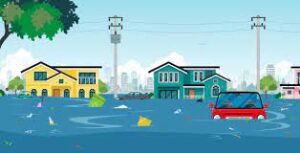
Lũ lụt thường là hiện tượng nước tràn tạm thời vào một khu vực thường khô ráo. Lũ lụt là thảm họa thiên nhiên phổ biến nhất ở Hoa Kỳ. Lũ lụt có thể xảy ra do mưa, tuyết, bão ven biển, nước dâng do bão và tràn đập và các hệ thống nước khác. Lũ lụt có thể phát triển chậm hoặc có thể xảy ra với ít hoặc không có cảnh báo trước (còn được gọi là Lũ quét). Lũ lụt gây mất điện, gián đoạn giao thông, làm hư hại các tòa nhà và có thể tạo ra lở đất.
Biết sự khác biệt giữa Theo dõi Lũ lụt và Cảnh báo Lũ lụt:
- Cảnh Báo Lũ Lụt có nghĩa là có thể xảy ra lũ lụt hoặc lũ quét trong khu vực của bạn.
- Cảnh báo Lũ lụt có nghĩa là lũ lụt hoặc lũ quét đang xảy ra hoặc sẽ sớm xảy ra. Thực hiện các biện pháp phòng ngừa NGAY LẬP TỨC.
Giữ An Toàn Trong Lũ Lụt:
- Sơ tán ngay lập tức, nếu được yêu cầu sơ tán. Không bao giờ lái xe xung quanh chướng ngại vật. Lực lượng ứng phó địa phương sử dụng các công cụ này để điều hướng giao thông ra khỏi khu vực ngập lụt một cách an toàn.
- Nghe đài khẩn cấp hoặc thông tin cảnh báo tại địa phương để biết thông tin khẩn cấp hiện tại và hướng dẫn liên quan đến lũ lụt.
- Không đi bộ, bơi lội hoặc lái xe qua vùng nước lũ. Quay lại. Đừng chết đuối!
- Tránh xa những cây cầu bắc qua dòng nước xiết. Nước chảy xiết có thể cuốn trôi cầu mà không báo trước.
- Ở trong xe của bạn nếu nó bị mắc kẹt trong dòng nước chảy xiết. Lên mái nhà nếu nước đang dâng lên bên trong xe.
- Lên tầng cao nhất nếu bị mắc kẹt trong một tòa nhà. Chỉ lên mái nhà nếu cần thiết và một khi đã lên mái nhà báo hiệu để được giúp đỡ. Không trèo lên gác mái kín để tránh bị mắc kẹt do nước lũ dâng cao.
Tài nguyên:
Sự cố Vật liệu Nguy hiểm (HazMat)
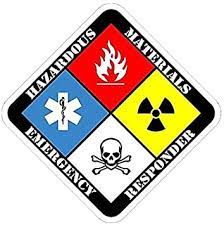
Vật Liệu Nguy Hiểm Sự cố có thể xảy ra khi hóa chất hoặc vật liệu có khả năng gây hại được thải ra cộng đồng. Sự cố Vật liệu Nguy hiểm (hoặc Sự cố HazMat) có thể xảy ra trong quá trình sản xuất, lưu trữ, vận chuyển, sử dụng hoặc thải bỏ hóa chất hoặc vật liệu có khả năng gây hại hoặc nguy hiểm. Trong Sự cố HazMat, bạn có thể được yêu cầu sơ tán hoặc trú ẩn tại chỗ. Dưới đây là các khuyến nghị về cách trả lời.
Nếu được yêu cầu sơ tán do Sự cố HazMat:
- sơ tán ngay lập tức
- Theo dõi đài phát thanh và truyền hình để biết thêm thông tin về các tuyến đường sơ tán, nơi trú ẩn tạm thời và mọi thủ tục cần thực hiện.
- Nhắn tin SHELTER kèm mã zip của bạn gửi tới 43362 để tìm nơi trú ẩn gần nhất trong khu vực của bạn (ví dụ: nơi trú ẩn 95119)
- Nếu bạn có thời gian, hãy đóng tất cả các cửa sổ, tắt tất cả các lỗ thông hơi và tắt quạt gác mái (nếu có) để giảm thiểu ô nhiễm trong nhà của bạn.
Nếu được yêu cầu trú ẩn tại chỗ do Sự cố HazMat:
- Mang vật nuôi và các thành viên gia đình vào bên trong.
- Đóng và khóa tất cả các cửa ra vào và cửa sổ bên ngoài. Đóng lỗ thông hơi, tắt lò sưởi và đóng càng nhiều cửa bên trong càng tốt.
- Tắt máy điều hòa không khí và hệ thống thông gió hoặc đặt hệ thống thông gió ở chế độ tuần hoàn 100% để không khí bên ngoài không bị hút vào tòa nhà.
- Sử dụng mặt nạ nếu có thể nếu khí hoặc hơi có thể xâm nhập vào tòa nhà.
- Tránh ăn hoặc uống bất kỳ thực phẩm hoặc nước có thể bị ô nhiễm.
- Đi vào phòng bên trong nhất của ngôi nhà.
- Bịt kín các khoảng trống bên dưới và xung quanh các khu vực sau bằng khăn ướt, tấm nhựa, băng keo, giấy sáp hoặc giấy nhôm:
- Cửa ra vào và cửa sổ
- Đơn vị điều hòa không khí
- Quạt thông gió phòng tắm và nhà bếp
- Lỗ thông hơi của bếp và máy sấy bằng băng keo và tấm nhựa.
Tài nguyên:
sóng thần
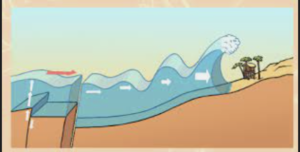
Sóng thần là một loạt sóng biển cực lớn gây ra bởi động đất, lở đất dưới nước, núi lửa phun trào hoặc thiên thạch. Sóng thần có thể giết chết hoặc làm bị thương người và làm hư hại hoặc phá hủy các tòa nhà và cơ sở hạ tầng khi sóng vào và ra. Sóng thần có thể di chuyển 20-30 dặm một giờ với sóng cao 10-100 feet. Sóng thần có thể gây ra lũ lụt và làm gián đoạn giao thông, điện, thông tin liên lạc và cấp nước. Sóng thần xảy ra bất cứ nơi nào dọc theo bờ biển Hoa Kỳ. Các bờ biển giáp với Thái Bình Dương hoặc Caribê có rủi ro lớn nhất.
Nếu bạn đang ở dưới Cảnh báo Sóng thần:
- Nếu Sóng thần là do động đất gây ra, HÃY THÁO, ẨN và GIỮ BẬT để bảo vệ bạn khỏi động đất trước.
- Lên vùng đất cao càng xa đất liền càng tốt.
- Cảnh giác với các dấu hiệu của sóng thần, chẳng hạn như nước biển dâng cao đột ngột hoặc nước biển rút cạn.
- Lắng nghe thông tin khẩn cấp và cảnh báo. Luôn làm theo hướng dẫn từ các nhà quản lý khẩn cấp tại địa phương.
- Nếu bạn đang ở ngoài khu vực có nguy cơ sóng thần và nhận được cảnh báo, hãy ở yên tại chỗ trừ khi các quan chức có thông báo khác cho bạn.
- Để tìm hiểu xem bạn có nằm trong vùng ngập lụt do sóng thần hay không, hãy xem các liên kết cụ thể của quận bên dưới.
- Sơ tán: ĐỪNG ĐỢI! Rời đi ngay khi bạn nhìn thấy bất kỳ dấu hiệu tự nhiên nào của sóng thần hoặc nhận được cảnh báo sóng thần chính thức.
- Các tuyến đường sơ tán thường được đánh dấu bằng một làn sóng có mũi tên chỉ hướng lên vùng đất cao hơn.
- Nếu bạn đang ở trên thuyền, hãy ra khơi xa hơn – đừng cố gắng vào bờ.
Tài nguyên:



